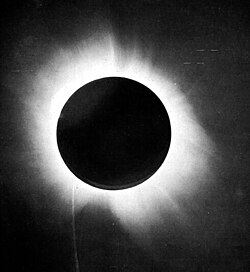| Annular eclipse | |
| Gamma | −0.2387 |
|---|---|
| Magnitude | 0.9383 |
| Maximum eclipse | |
| Duration | 426 s (7 min 6 s) |
| Coordinates | 36°06′S53°42′W / 36.1°S 53.7°W |
| Max. width of band | 236 km (147 mi) |
| Times (UTC) | |
| Greatest eclipse | 15:22:02 |
| References | |
| Saros | 131 (45 of 70) |
| Catalog # (SE5000) | 9325 |
An annular solar eclipse occurred at the Moon's ascending node of orbit on Tuesday, December 3, 1918, [1] with a magnitude of 0.9383. A solar eclipse occurs when the Moon passes between Earth and the Sun, thereby totally or partly obscuring the image of the Sun for a viewer on Earth. An annular solar eclipse occurs when the Moon's apparent diameter is smaller than the Sun's, blocking most of the Sun's light and causing the Sun to look like an annulus (ring). An annular eclipse appears as a partial eclipse over a region of the Earth thousands of kilometres wide. Occurring 4.3 days after apogee (on November 29, 1918, at 7:10 UTC), the Moon's apparent diameter was smaller. [2]
Contents
- Eclipse details
- Eclipse season
- Related eclipses
- Eclipses in 1918
- Metonic
- Tzolkinex
- Half-Saros
- Tritos
- Solar Saros 131
- Inex
- Triad
- Solar eclipses of 1916–1920
- Saros 131
- Metonic series
- Tritos series
- Inex series
- Notes
- References
Annularity was visible from Chile including the capital city Santiago, Argentina including capital Buenos Aires, southern Uruguay including capital Montevideo, northeastern tip of South West Africa (today's Namibia) and southwestern Portuguese Angola (today's Angola). Aconcagua, the highest mountain outside Asia, also lies in the path of annularity. A partial eclipse was visible for parts of South America, Antarctica, Southern Africa, and Central Africa.








































































































